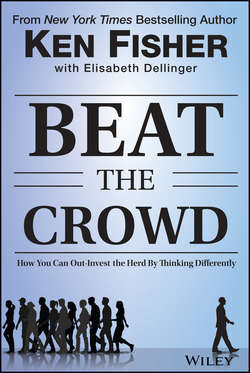Читать книгу Beat the Crowd - Kenneth Fisher - Страница 8
На сайте Литреса книга снята с продажи.
CHAPTER 1
Your Brain-Training Guide
There Is Always a But
ОглавлениеThe market is The Great Humiliator. TGH for short. Its goal is to humiliate as many people as possible as often as possible for as long as possible. Preying on the herd is its bread and butter – humiliates a whole bunch of investors at once! The crowd is the easy, typical prey, but TGH spares no one forever. Even true contrarians get whacked.
No approach works all the time, including assuming the crowd is wrong. Sometimes, they’re right! The market usually doesn’t do what everyone expects, but there are always exceptions. If TGH didn’t let the crowd be right sometimes, there wouldn’t be a crowd! Momentum investors – those whose guiding principle is “The trend is your friend” – would be proven wrong the moment they invest. Markets would slap most folks in the face as soon as they buy – or sell – and people would learn from their mistakes. Stocks wouldn’t have anyone to fool, and fooling folks is one of the market’s greatest pleasures.
People must be right sometimes, must feel good sometimes, or we’d never have a herd. They would just give up. The occasional rightness fosters false confidence, reinforcing the crowd’s wisdom. It is plausible deniability for TGH. It is how TGH repeatedly sucks the crowd in, makes them ignore negatives, then doles out maximum pain and suffering. (TGH probably then enjoys a cartoon-villain-like laugh.) This is why seasonal myths like “Sell in May” and “September is the worst month” ring true. Even though they’re wrong more often than not, they’re right sometimes. Those times when May, summer and September returns look sad, coupled with below-average historical returns for May through September, keep the myth alive. Occasional and often dramatic rightness gives myths power.
Markets often let the crowd look right temporarily, before turning on them. Folks who believed the eurozone crisis would end the bull market in 2011 looked awfully right that October, when world stocks were at the bottom of a deep correction. But stocks bounced and the bull carried on in 2012, 2013 and beyond, shrugging off history’s largest sovereign default in Greece along the way, ultimately proving the euro doom-mongers wrong (or very untimely, also effectively wrong).
Sometimes, markets’ wobbles let folks think they’re right, like when a correction comes after headlines warn some big evil will rock stocks. Corrections – sharp drops of –10 % to –20 % over a few weeks or months – come any time, for any reason or even no reason. But fear-mongers often assume conveniently timed corrections are proof that whatever they warned about was as big and bad as they said. This isn’t fundamental rightness – just confirmation bias (seeing what you want to see), a dangerous behavioral phenomenon, but most folks don’t bother differentiating between fundamental rightness and happenstance. (More on this in Chapter 9.)
Just as the crowd is sometimes right, true contrarians are sometimes wrong. Everyone is wrong sometimes! The goal is simply being right more often than wrong, as opposed to looking right at first but ultimately being wrong more often than not.
